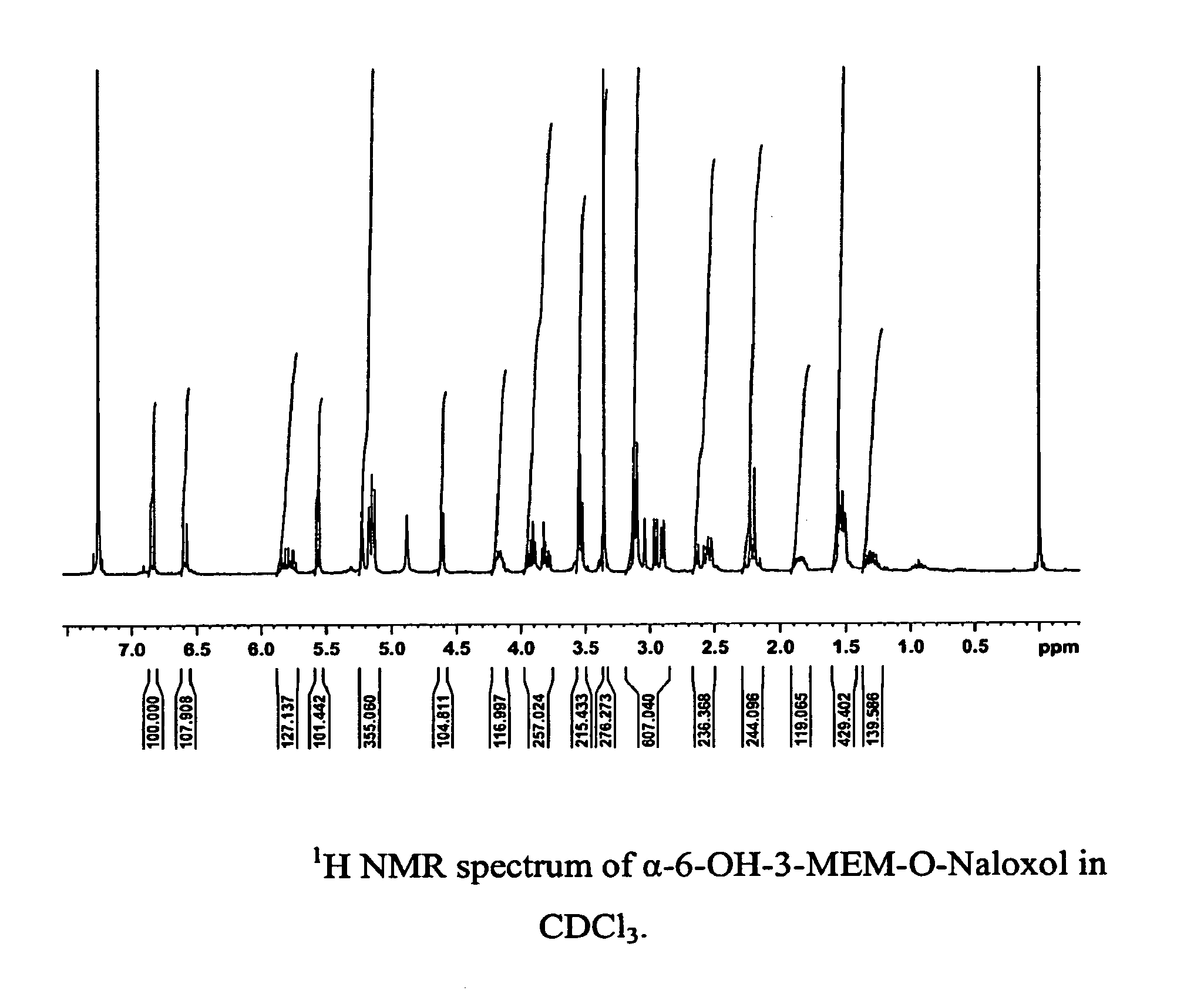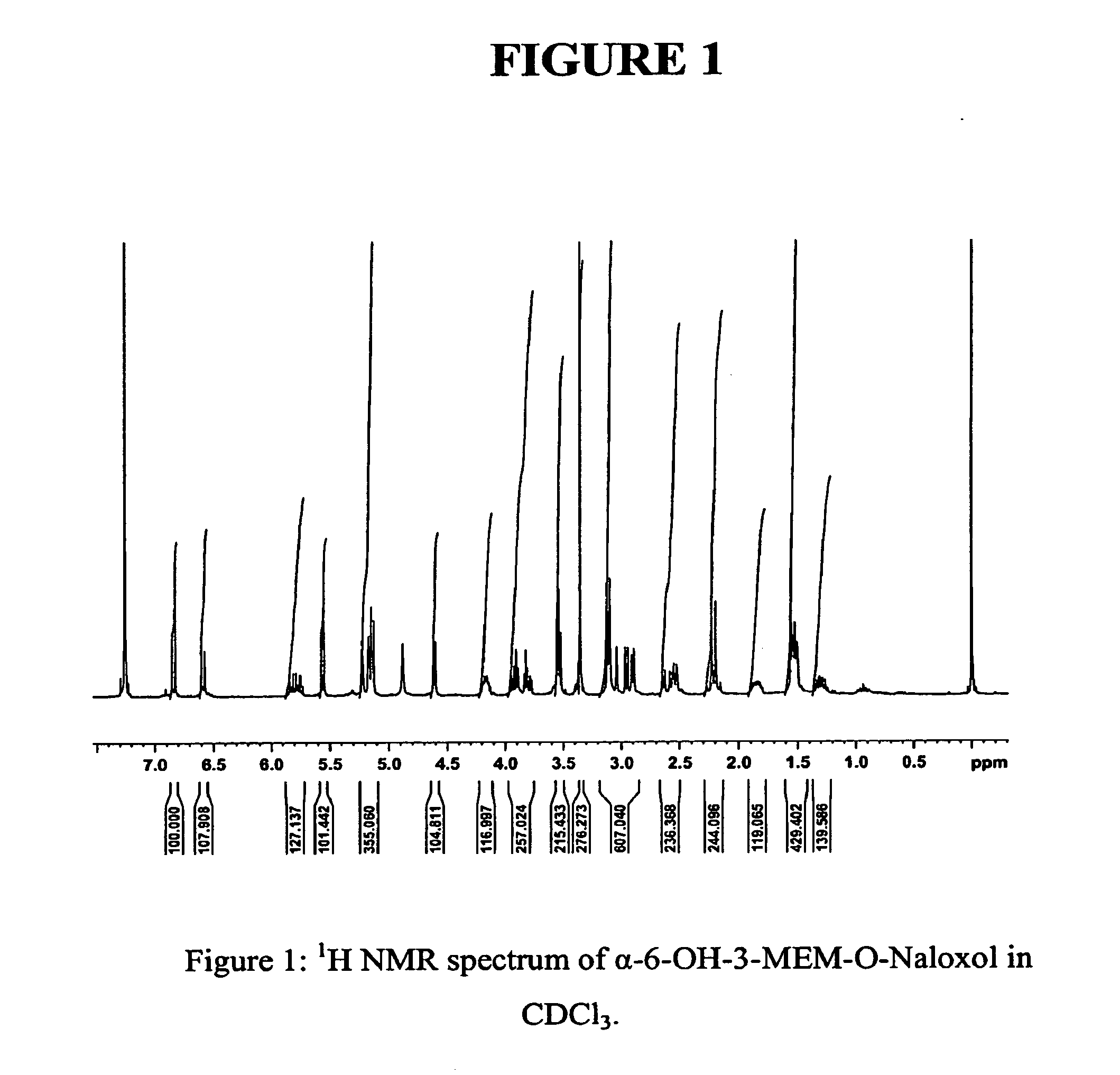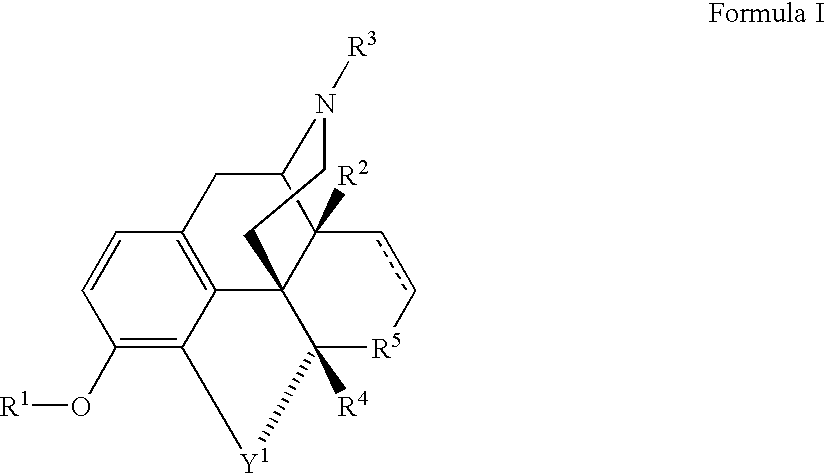Stereoselective reduction of a morphinone
a morphinone and selective reduction technology, applied in the field of chemical synthetic methods, can solve the problems of inability to attach a poly(ethylene glycol) derivative to an active agent, difficulty in achieving the effect of binding,
- Summary
- Abstract
- Description
- Claims
- Application Information
AI Technical Summary
Benefits of technology
Problems solved by technology
Method used
Image
Examples
example 1
Preparation of Substantially Pure α-6-OH-3-MEM-O-Naloxol Using K-tri-sec-butylborohydride
[0181]
[0182]To a solution of 3-MEM-O-naloxone base (2.0 g, 4.8 mmol, preparation described in U.S. Patent Application Publication No. 2005 / 0136031) in dry tetrahydrofuran (50 mL) under an inert atmosphere at −20° C., was added a 1M solution of potassium tri-sec-butylborohydride (7.2 mL, 7.2 mmol) slowly over 15 minutes. The solution was stirred continuously at −20° C. under a nitrogen atmosphere for an additional 1.5 hours and then water (10 mL) was added slowly. The reaction mixture was stirred another 10 minutes at −20° C. and allowed to warm to room temperature. The solvent was removed under reduced pressure and the remaining residue was dissolved in CH2Cl2 (100 mL). The CH2Cl2 phase was extracted with a 0.1 N HCl / NaCl water solution (3×100 mL) and the combined aqueous extracts were washed with CH2Cl2 (1×300 mL). Sodium carbonate was added to bring the aqueous solution to pH=8. The solution w...
example 2
Preparation of Substantially Pure α-6-OH-3-MEM-O-Naloxol Using Na-tri-sec-butylborohydride
[0185]
[0186]To a solution of 3-MEM-O-naloxone base (100 mg, 0.24 mmol, preparation described in U.S. Patent Application Publication No. 2005 / 0136031) in dry tetrahydrofuran (8 mL) under an inert atmosphere at −20° C., was added a 1M solution of sodium tri-sec-butylborohydride (0.36 mL, 0.36 nmol) slowly. The solution was stirred continuously at −20° C. under a nitrogen atmosphere for an additional 1.0 hour and then water (1 μL) was added slowly. The reaction mixture was stirred another 10 minutes at −20° C. and allowed to warm to room temperature. The solvent was removed under reduced pressure and the remaining residue was dissolved in CH2Cl2 (30 mL). The CH2Cl2 phase was extracted with a 0.1 N HCl / NaCl water solution (3×30 mL) and the combined aqueous extracts were washed with CH2Cl2 (1×30 mL). Sodium carbonate was added to bring the aqueous solution to pH=8. The solution was extracted once ag...
example 3
Preparation of Substantially Pure α-6-OH-3-MEM-O-Naloxol Using Sodium Triethylborohydride
[0188]
[0189]To a solution of 3-MEM-O-naloxone base (100 mg, 0.24 mmol, preparation described in U.S. Patent Application Publication No. 2005 / 0136031) in dry tetrahydrofuran (6 mL) under an inert atmosphere at 0° C. (via an ice bath), was added a 1M solution of sodium triethylborohydride (0.36 mL, 0.36 mmol) slowly. The solution was stirred under a nitrogen atmosphere for 5.0 hours and slowly warmed to room temperature; then acetic acid (0.5 mL) was added slowly to destroy excess sodium triethylborohydride. The solvent was removed under reduced pressure and the remaining residue was dissolved in CH2Cl2 (30 mL). The CH2Cl2 phase was extracted with a 0.1 N HCl / NaCl water solution (3×30 mL) and the combined aqueous extracts were washed with CH2Cl2 (1×30 mL). Sodium carbonate was added to bring the aqueous solution to pH=8. The solution was extracted once again with CH2Cl2 (3×30 mL) and the organic e...
PUM
| Property | Measurement | Unit |
|---|---|---|
| polydispersity | aaaaa | aaaaa |
| polydispersity | aaaaa | aaaaa |
| temperature | aaaaa | aaaaa |
Abstract
Description
Claims
Application Information
 Login to View More
Login to View More - R&D
- Intellectual Property
- Life Sciences
- Materials
- Tech Scout
- Unparalleled Data Quality
- Higher Quality Content
- 60% Fewer Hallucinations
Browse by: Latest US Patents, China's latest patents, Technical Efficacy Thesaurus, Application Domain, Technology Topic, Popular Technical Reports.
© 2025 PatSnap. All rights reserved.Legal|Privacy policy|Modern Slavery Act Transparency Statement|Sitemap|About US| Contact US: help@patsnap.com



